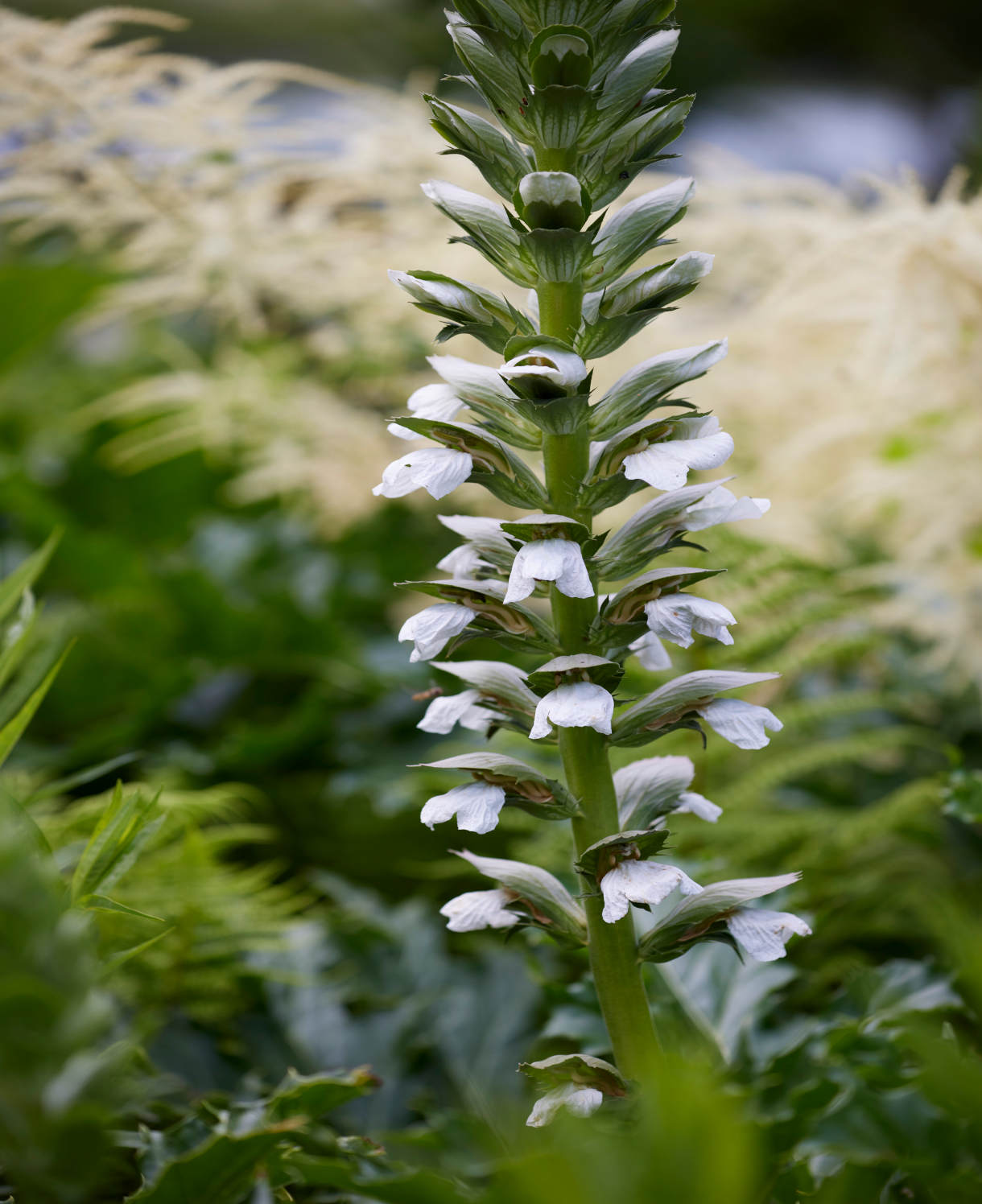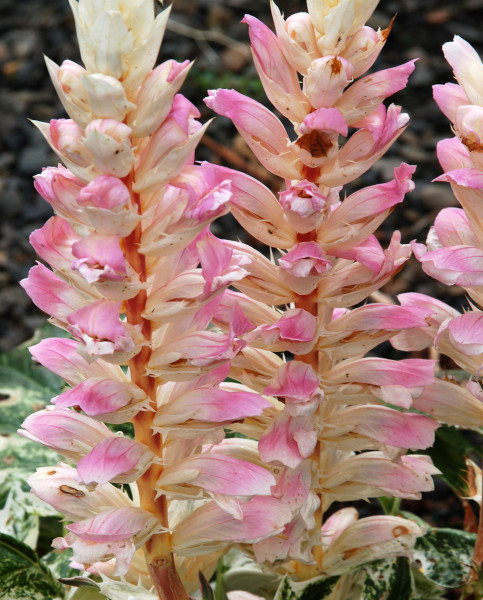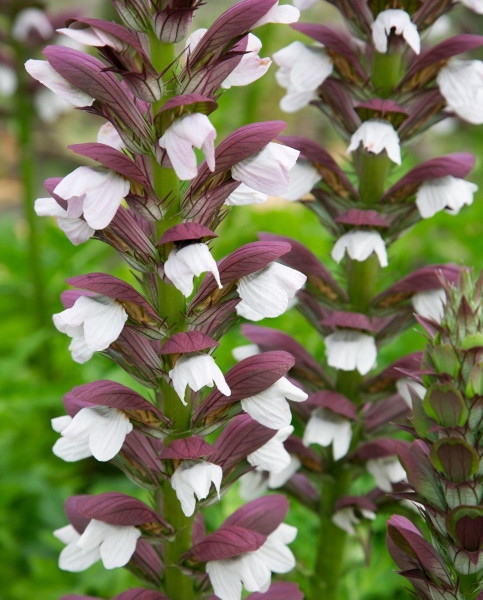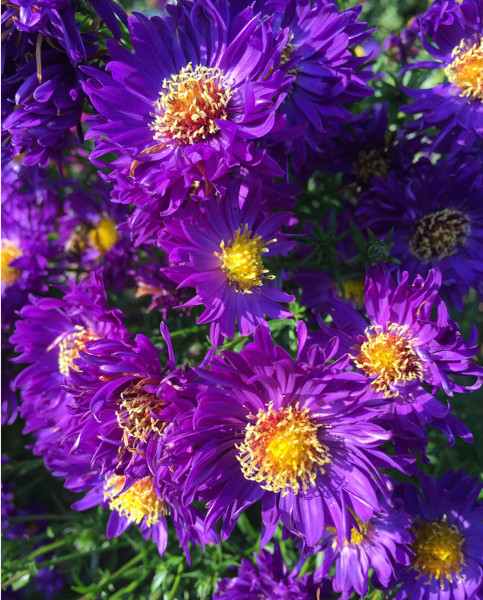How to grow Acanthus
Fast-growing, architectural plants with large, striking foliage and a proliferation of flower spikes. Foliage tends to be deeply lobed, often glossy and dark green, with some species pricklier than others. Flowers are tall, upright spikes of pale pink or white blooms, each visible beneath a purple ‘hood’, or bract.
Acanthus are clump-forming perennials, originating largely from the Mediterranean. They are also known by the common name ‘Bear’s Breeches’. The leaves of acanthus were commonly used as a motif in Greco-Roman and Classical architecture.
Reliable and fairly indestructible garden plants, acanthus are tolerant of a wide range of conditions and as such are useful for trickier spots. A spreading habit means they are very good at colonising an area – a characteristic to be mindful of when selecting a planting spot.
The species on offer for sale by Hayloft can be differentiated by the following qualities:
- hungaricus is particularly shade tolerant, as well as being the most compact in size and strongest in scent. Flowers in early to mid-summer.
- mollis has broad leaves, the softest of the three species (mollis being latin for soft, pliant, gentle). Flowers in late summer.
- spinosus is more dramatic and angular in appearance, with spiny, stiff, deeply lobed foliage. Flowers in late spring to mid-summer.

Key Information
Soil pH
Position
Hardiness


Where & when to plant Acanthus
For best results, plant in autumn or spring. An autumn planting can be done by those gardening in mild conditions (and broadly speaking, this is the southern half of the UK). For those liable to cold winters, it is best to wait until spring (generally the northern half of the UK). Planting can also be carried out in summer, though be prepared to water regularly.
It is important to think carefully before planting acanthus, for several reasons.
- They are known to be very deep rooting and therefore difficult to move once established. In other words, make sure you get the location right first time!
- Any small fragment of root left in the ground will regrow, making them almost impossible to eradicate once planted.
- Many species have a vigorous, spreading habit and will quickly colonise an area. This can make them difficult to incorporate into a border.
With all this in mind, acanthus are generally recommended for providing dramatic, leafy ground cover either where their dominance won’t be a problem (such as a wild corner or compost area), or where their spread is somehow contained (perhaps enclosed by hard landscaping, or hemmed into the corner of a border by trees or shrubs). Some of the smaller species such as A. sennii can be grown comfortably in a pot, though larger species do best in open ground.
Don’t let the above words of caution deter you – acanthus is invaluable for growing quickly and robustly in areas where often little else will thrive. Used in the right way it can make a wonderful addition to the garden.
In terms of choosing the right species for a particular spot, A. hungaricus is particularly shade tolerant, and with its softer leaves A. mollis is the best choice for anywhere you brush past. A. spinosus is spiny, stiff, and makes an excellent security barrier for unwanted garden visitors.
How to plant Acanthus
- For planting in the garden, dig the soil area removing any large stones and weeds and breaking up any lumps. Rake level and firm with your heels. Rake level again.
- Water plants well and allow to drain before planting.
- A good tip is to dig a hole twice the size of the root-ball. Fill with water and allow to drain before placing in the plant.
- Place the plant in the hole, ensuring the top of the root ball sits level with the surface of the soil. Too low and the plant may rot, too high and the roots can dry out.
- Backfill with soil and firm in gently with your foot.
- Soak well with water.
- Mulch around the base with well-rotted organic matter.
- For planting in containers (remember – we recommend using compact species and cultivars only for this), first choose an appropriately sized pot. The best practice is to start just a few centimetres larger than the rootball and increase in size every year or two. Always ensure there are plenty of drainage holes in the bottom.
- If you are using a large or heavy pot, it can be a good idea to fill and plant it in situ to save yourself the trouble of moving once full.
- Use a good quality potting compost with plenty of horticultural grit mixed in, and, if not already present in the compost (check the description on the bag) some slow-release fertiliser granules.
- Start by partially filling the pot with compost; enough so that when placed on it the upper surface of the root ball is about 3cm lower than the top of the pot.
- Infill all the space surrounding the root ball with compost, firming down with your fingers then adding a little more so the plant is held tight.
- Pick up the container and lightly tap on the potting bench or ground a few times to help further settle the compost around the plant.
- Soak well with water.
- A mulch with horticultural grit will look attractive and help to prevent a ‘cap’ or crust forming on the top of the compost (something container plants can suffer due to the artificial nature of their watering).

What to plant with Acanthus
Acanthus are incredibly versatile plants, looking good both in a bold, architectural context as well as in a more informal, naturalistic scheme.
Pair with clipped box and ferns for a simple, clean, minimalist look:
- Shop box
- Shop fern
Plant with drifts of stipa, astrantia and asters to achieve a soft, relaxed, natural effect:
- Shop stipa
- Shop astrantia
- Shop asters
If you would like any further planting ideas or growing advice for your acanthus, please contact our friendly and knowledgeable Customer Care Team - we will be more than happy to help you.



How to care for Acanthus
Pruning and Deadheading
Cut back spent flower heads throughout the flowering season if they begin to look untidy, otherwise they can be left as the seedheads also have an interesting, architectural form. Remove dead foliage in spring, before the new shoots begin to appear. Lift and divide in autumn or spring to reduce spread.
Watering
Water your acanthus well until fully established. After this, water in hot, dry spells to help reduce the formation of powdery mildew which will impact upon the aesthetic value of the plant.
Cold Protection
Acanthus are very hardy and robust plants, requiring no frost protection.
Pests and Diseases
Powdery mildew may be a problem on acanthus. Keep yours watered in dry spells to avoid this and ensure the plant enjoys good air circulation.
How to propagate Acanthus
Acanthus are easy to propagate, using one of the two following methods.
The quickest and easiest approach is to lift and divide established clumps in spring or autumn:
- Choose a day when the soil is not frozen or waterlogged
- Dig the plant out of the ground using a strong spade or fork and shake off any excess soil
- Separate the plant into sections using either swift, cutting blows with a sharp spade, or two forks inserted back-to-back with tines touching, handles then pushed together to prise the plant apart
- Discard old, damaged or surplus pieces (do not put these on your compost heap as they will regrow), keeping healthy, vigorous material
- Dig over entire area, removing as many roots as possible (these will each reshoot). Replant or pot up selected pieces as required
Take root cuttings in winter:
- Using a trowel, locate roots close to the crown of the plant. Select roots of approximately pencil thickness
- With secateurs, take cuttings of around 5-10cm in length
- To ensure cuttings are potted the right way up, make a straight cut at the top end (closest to crown), and a slanted cut at the bottom end (furthest from crown)
- Insert cuttings upright in pots of perlite-heavy compost (at least 50% perlite), the top end flush with the surface
- Top dress with sand or fine grit. Water lightly and place in cold frame or cool greenhouse
- Pot up in spring when cuttings show signs of growth
Common Acanthus Questions
What uses does acanthus have?
These plants make excellent cut or dried flowers for use in arrangements. They are also very attractive to pollinators.
Why is my acanthus going mouldy in warm weather?
This is powdery mildew, usually affecting plants under water stress and lacking in adequate air circulation. Address the circulation issue by thinning out foliage; address water stress by keeping watered in hot, dry spells, and mulching regularly.
Why is my acanthus not flowering?
This could be due to a couple of factors. Firstly, slugs and snails may be eating the soft flower heads as they emerge from the crown of the plant. Check regularly, removing any of these pests by hand. Secondly, a late frost may have damaged early flower buds. Prune off any damaged growth to encourage a second flush.
Is acanthus invasive?
Most acanthus are vigorous plants which, if not kept in check, can take over an area. Lifting, dividing, and replanting a smaller clump every few years can help with this, as well as being useful in maintaining the health of the plant. Be aware that acanthus will reshoot from any piece of root left in the ground, so dig over the area thoroughly to minimise this.




